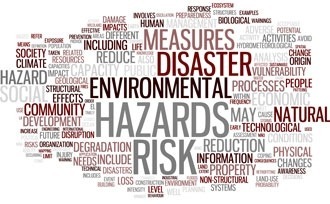

"City governments should identify and understand their risk, including hazards, exposure and vulnerabilities, and use this knowledge to inform decision making."
Disaster risk management need to be based on an understanding of disaster risk scenarios in all its dimensions of hazard characteristics, local exposures, capacity and vulnerability. Risk scenarios analysis and assessments therefore are essential for informed decision making, prioritizing projects and planning for disaster risk reduction measures (prevention, mitigation, preparedness and response). Unless local governments have a clear understanding of the risks they face as well as fully discuss with the public and other stakeholders about risk scenarios, implementation of meaningful disaster risk reduction measures may be ineffective.
- Take into consideration how hazards might change over time given the impact of factors such as urbanization and climate change, how multiple hazards might combine, and how repeated small scale disaster events (if there is a relevant risk of these) might accumulate in their impact over time;
- Prepare and maintain an updated database on: geographic areas exposed and territorial impact; population segments, communities and housing exposed; economic assets and activities exposed including its impact on the social, health, education, environmental, and cultural heritage; critical infrastructure assets exposed, the consequent risk of cascading failures from one asset system to another;
- Estimate timescales over which risks, vulnerabilities and impacts occur as well as responses required;
- Create and publish maps of risk and exposure detailing the above.
- Seek inputs from the full range of stakeholders (including ethnic and social groupings);
- Update the risk scenario assessment regularly;
- Set the basis for current and future investment decisions;
Widely communicate and use risk scenario assessments for decision-making purposes, and updating of response and recovery plans.
Many countries, particularly in Latin America, have systems for assessing the impact of disaster risk on productive infrastructure. The UNDRR Global Assessment Report 2011 highlights Peru, which established a pioneering legal requirement that all public investment projects be evaluated for disaster risk. If the risk is not addressed, the project will not be funded. Of the US $10 billion investment approved in 2008, about a half was to be executed by local governments.
Similarly, under its Disaster Risk Management (DRM) framework, the city of Cape Town has established the principle that the Municipal DRM Center be involved in the project review process on all new development projects.
Read more about opportunities and incentives for disaster risk reduction management at: http://tinyurl.com/7sganme and consult Cape Town’s DRM framework at http://tinyurl.com/cw9n22x
Mahila Milan is a women’s group taking leadership roles in informal settlements. The mapping process in Cuttack, India is carried out by community organisations comprised of residents of informal settlements and other districts, through a partnership between local Mahila Milan groups and local slum dweller federations. The data gathered is used to generate digital maps for city authorities and to negotiate support for upgrading or relocating houses, thus reducing disaster risk. This process is applied in all informal settlements and results in an accurate, detailed and disaggregated database on risk and vulnerability for the entire city, showing the boundaries of all informal settlements.
For more information: http://tinyurl.com/7wg3ktd
World Bank, UN-Habitat, UNEP, and Cities Alliance
The World Bank, with UN-Habitat, UNEP, and Cities Alliance, has developed an urban risk assessment framework based on experiences in many cities. The urban risk assessment offers a flexible approach that project and city managers can use to identify feasible measures to assess a city’s risk. The methodology focuses on three reinforcing pillars that collectively help to understand urban risk: a hazard impact assessment, an institutional assessment, and a socioeconomic assessment. The assessment is based on four principal building blocks to improve the understanding of urban risk: historical incidence of hazards, geospatial data, institutional mapping, and community participation. The URA is flexible in how it is applied, depending on available resources and institutional capacity in a given city. Read more at: http://go.worldbank.org/VW5ZBJBHA0
-
Urban Risk Assessments: Towards a Common Approach – World Bank (2011)Urban Risk Assessments: Towards a Common Approach – World Bank (2011)
A framework for carrying out urban risk assessment, seeking to strengthen coherence and consensus on how cities can plan for natural disasters and climate change. -
Techniques Used in Disaster Risk Assessment – UNHABITAT
A portal to exchange DRR assessment tools and case studies. Search under ‘Comprehensive Disaster Risk Assessment;’ more under ‘Techniques Used in Disaster Risk Assessment.’ -
Assessing the Vulnerability of Local Communities to Disasters – UNEP (2008)
A risk profile tool to help communities make a rough estimate of their exposure to risks. -
Urban Governance and Community Resilience Guide on Risk Assessment in Cities – ADPC (2010)
A series of guidebooks designed to raise awareness of the challenges local governments face in reducing disaster risk -
HAZUS: Software for Risk Assessment and Modelling of Disasters – FEMA (2011)
GIS-based software to estimate potential losses from earthquakes, floods, and hurricanes. -
Earthquake Risk Assessment Tools – Earthquake Engineering Research Institute (USA)
Website with information on ways to reduce losses from earthquakes. Search for the ‘Toolkit for Decision Makers’ by the California Seismic Safety Commission (1999) -
Urban Risk Assessment: A Facilitator's Guidebook – ADPC, ECHO, Handicap International, Islamic Relief, Plan International (2010)
How to scale down the urban risk assessment process from city to community level to get all groups involved in preparing for a disaster. -
Discovery of a “Hot Spot” – World Bank GFDRR
Assessment exercise worksheet, extracted from the GFDRR publication ‘Climate Resilient Cities’ (see section on General Guidance). -
Weathering the Storm: Participatory Risk Assessment for Informal Settlements – Disaster Mitigation for Sustainable Livelihoods Programme, U. of Cape Town, South Africa (2008)
The guide simplifies participatory risk assessment methods for use in integrated disaster risk management planning at settlement level.
